lies like truth: September 2010 Archives
 I dropped in to a bar on Polk Street last night when the weekly pub quiz was in full flight. I've played a couple of quizzes in bars in my time, but it wasn't until I experienced this is as a sort of semi-player, semi-viewer, that I really got to appreciate how lively these kinds of events are from a cultural perspective.
I dropped in to a bar on Polk Street last night when the weekly pub quiz was in full flight. I've played a couple of quizzes in bars in my time, but it wasn't until I experienced this is as a sort of semi-player, semi-viewer, that I really got to appreciate how lively these kinds of events are from a cultural perspective.My friends and I arrived at Blur Bar too late to actually participate in the establishment's "Trivia Night" as an official team. Nevertheless, we hung out, drank and answered the questions anyway. Here's what I appreciated about the event:
1. Coming up with a catchy name for your team requires creative effort. "Hardly Strictly Geniuses" (named after the Hardly Strictly Bluegrass festival happening in Golden Gate Park this weekend) was my favorite of last's night's selection.
2. People in the same team often synchronize outfits. The members of one team were all wearing blue t-shirts, which I thought was a nice touch.
3. The questions are challenging and you have to pool all your resources as a team to figure the answers out. I led my friends astray by naming the daffodil as the totem that St. David used to lead his Welsh troops, when in fact it was the leek. I should have engaged them in a discussion about it instead of cockily thinking I had the right answer.
4. The rounds are separated by fabulously cheesy pop music. There is lots of time for relaxation, drinking and chatter.
5. The event inspires strangers to talk to each other in a much more engaged way because everyone has the trivia challenge in common. I heard several conversations along the lines of "did you get the answer to question 5? That was hard" going on around me.
6. Pub quiz culture refreshingly inspires an honor code. I only once saw an iPhone in use. That was when my friend decided to do an image search for Etta James during the picture round. His excuse was that we weren't participating officially.
 I was chatting with the executive director of a prominent music ensemble over coffee the other day. Her group often performs concert programs in Berkeley but, unusually, no East Bay performances were scheduled for the ensemble's recent program of concerts.
I was chatting with the executive director of a prominent music ensemble over coffee the other day. Her group often performs concert programs in Berkeley but, unusually, no East Bay performances were scheduled for the ensemble's recent program of concerts.I asked her why. Her answer surprised me:
"People in Berkeley like old music and new music but nothing in between."
I know that there are lots of early and contemporary music fans in the East Bay. But it seems odd to me that the ensemble, which has an international reputation, couldn't find enough of an audience for a program that features the "in between" repertoire in Berkeley. I'm curious to know if other groups presenting work around the Bay would agree...?
P.S. I, for one, would have gladly made the trip across the Bay to hear the concert as the San Francisco date didn't work with my schedule. And I know from talking to music lovers around here that many San Francisco people prefer attending concerts in Berkeley venues than in San Francisco because they like the venues better.
 San Francisco Opera's latest Opera at the Ballpark simulcast was, by most standards, an unparalleled success. 32,000 people -- a record attendance in the five years that the company has mounted the program -- flocked to AT&T Park to picnic and watch a live broadcast of SF Opera's current production of Aida last Friday night.
San Francisco Opera's latest Opera at the Ballpark simulcast was, by most standards, an unparalleled success. 32,000 people -- a record attendance in the five years that the company has mounted the program -- flocked to AT&T Park to picnic and watch a live broadcast of SF Opera's current production of Aida last Friday night.As usual I very much enjoyed the event. (What's there not to like about lying on the softest, cleanest grass in the world on a warm evening with friends, a bottle of wine, good cheese and bread and performances by some of the world's top opera singers?) But the choice of opera left much to be desired.
Opera broadcasts are very unforgiving on performers' physiques and SF Opera picked the one production in its season that has probably the most uncomely cast of all. Dolora Zajick is an incredible singer. And from a distance at the opera house itself, you can almost believe that she's the teenage daughter of an Egyptian king. But up close when viewed on a screen, the fifty-something star simply doesn't pull it off.
And the gaudy costumes and sets designed by Zandra Rhodes make everyone on stage without exception look like escapees from the Trannyshack pageant that also happened to be going on in San Francisco on Friday night. The low-cut square neckline of Marcello Giodarni's costume as Radames was particularly unkind to the tenor's generous thicket of chest hair.
A populist opera like Aida is probably the best choice for the ballpark event. But I think something stylistically lighter from the current season featuring more photogenic performers, such as The Marriage of Figaro starring the gorgeous Danielle de Niese and Ellie Dehn, would have been a better choice.
Still, once the stage darkened in the final scene, leaving Aida and Radames together to lament their untombely deaths, I couldn't help but be moved. The garish set designs faded away and the singers lost us in Verdi's climactic, soulful music. There was a full moon over the Ballpark that night. I will never forget it.
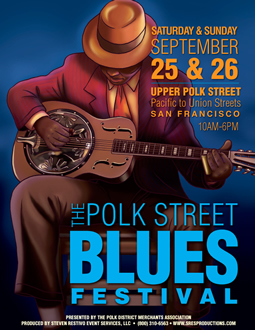 Days like I had on Saturday remind me of the sheer joy of living in this part of the world. There is no other place quite like it for off-the-radar cultural encounters and non-everyday experiences.
Days like I had on Saturday remind me of the sheer joy of living in this part of the world. There is no other place quite like it for off-the-radar cultural encounters and non-everyday experiences.It all started at House of Air, a new trampolining park at Crissy Field. The company launched less than two weeks ago and I when I showed up, was packed mostly with children bouncing up and down to their heart's content. In addition to keeping kids occupied, House of Air trains athletes to do aerial stunts on skis, snowboards and skateboards and accommodates adults too. The company allows people to team up and play bouncy versions of basketball and dodgeball -- something that organizations might enjoy the novelty of when they go there for corporate meetings and events. One of these days, I might hit up one of HOA's trampolining exercise classes which happens every morning at 7am. Trampolining is, somewhat surprisingly, very good exercise: I jumped for about 20 minutes and was completely exhausted by the time I staggered off to switch out of the special jumping booties I'd been lent and back into my sandals.
The day unfurled with an afternoon spent at the Polk Street Blues Festival. The event was bustling in the early afternoon with bands crafts merchants and food and beverage sellers all keeping people entertained. I was particularly impressed by the gravely voice of a female vocalist in a soul band and another ensemble's crack harmonica player, who was just 12 years old and blew a mean harp.
Then I went to The Balclutha, an antique cargo vessel docked at Hyde Street Pier, for a concert featuring two important local chantey groups. Spent a merry couple of hours listening to old sea ballads and work songs performed by the Barbary Ghost trio and Salty Walt and the Rattlin Ratlines as well as exploring the bowels of the remarkable ship. A full moon was out, which made for an even more beautiful experience.
The adventure culminated with jazz at Ana Mandara, a lovely Vietnamese restaurant and lounge in Fisherman's Wharf. Bassist Gary Brown, pianist Peter Horvath and their guests provided the perfect landing to a day that started up in the air.
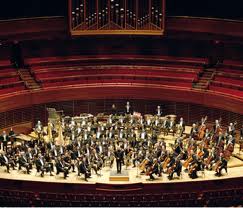 Last night at the Berkeley Symphony, I was chatting to a patron about my new role as the organization's resident dramaturg. He said: "Gosh, that means you won't be able to write about the orchestra anymore," in concerned terms.
Last night at the Berkeley Symphony, I was chatting to a patron about my new role as the organization's resident dramaturg. He said: "Gosh, that means you won't be able to write about the orchestra anymore," in concerned terms.Well obviously I won't be able to write about the orchestra anymore. But his comment seems totally beside the point. In my twice monthly column about culture for the New York Times / Bay Citizen, I have to cover all the arts, and classical music is one of many fields to write about. If I ever did get to write about the Berkeley Symphony, it might be once every couple of years, if that, as the region is so rich with classical music material to cover. So it's not like the orchestra would be losing out on any big media coups there.
I'm guessing -- and hoping -- that the Berkeley Symphony will gain a lot more from having me teach classes, organize interesting pre-concert programming and find other creative ways of connecting audiences to the music than it would by having me scribble an occasional half-baked commentary about its concerts here on my blog.
It's an interesting experiment at any rate and I applaud the orchestra for going in this direction. We'll see what happens.
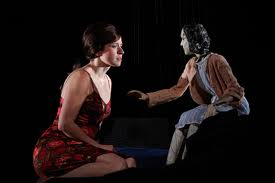 A great playwright is like a puppet master: He or she subtly pulls the strings of character and action to make life seem larger than it is in reality. Ideally, he or she resides in the shadows and the puppet/play itself takes center stage.
A great playwright is like a puppet master: He or she subtly pulls the strings of character and action to make life seem larger than it is in reality. Ideally, he or she resides in the shadows and the puppet/play itself takes center stage.Compulsion by Rinne Groff, which is currently receiving its world premiere at the Berkeley Repertory Theatre in a production starring Mandy Patinkin as an obsessed and egomaniacal writer and directed by Oskar Eustis of The Public Theatre, features puppets created by Matt Acheson and delicately manipulated by Emily DeCola, Daniel Fay and Eric Wright. It's a chewy, sinuous, contemplative piece about the tension between the self and the community, personal and social politics and the commercialism that often gets caught up even the most heartfelt of artistic endeavors. But the dramatist, though ambitious, gets her dramaturgical strings tangled.
The various strands of Groff's real-life historical content (to do with Anne Frank, the circumstances surrounding the adaptation of her famous Diary, the life of the writer Meyer Levin and the Leopold and Loeb murder case) all feel jumbled and like they should exist in separate plays, rather than feeling part of one work. The puppet metaphor doesn't feel well-integrated into the storytelling, the material is repetitive at times (there's only so much listening to a writer rant about his right to tell Anne Frank's story as a Jew that I can take) and I found that I didn't much care about the characters by the end of the play.
This is a shame as the acting from the three-strong cast, which features Hannah Cabell and Matte Osian alongside the excellently verkakte Patinkin, is sensitive and engrossing. There's a gorgeous fragility to the way in which the puppeteers manipulate their marionettes. And the pacing of the action by Eustis is mostly electric.
Yet I felt disappointed. The play, with its magical realism mixed with Arthur Miller-like naturalism reminds me of Paula Vogel's lovely puppet play The Long Christmas Ride Home. But it lacks the same authenticity and clever meshing of ideas.
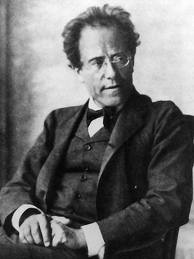 A few days ago, the rules that govern the selecting of repertoire for an orchestral season came up for discussion at a dinner party with a couple of friends, one of whom happens to be the music director of a symphony orchestra.
A few days ago, the rules that govern the selecting of repertoire for an orchestral season came up for discussion at a dinner party with a couple of friends, one of whom happens to be the music director of a symphony orchestra.When the idea of performing the music of Mahler came up, the conductor looked horrified. "I would never program Mahler in this town!" she said.
The reason for this comment wasn't to do with the fact that she doesn't like Mahler's music. Quite the opposite: She loves the composer's works. But because a conductor in the same region is particularly known for his Mahler concerts and recordings, she balks at the idea of attempting the same repertoire.
It makes sense for a conductor to cleave their own path and champion composers' with whom they feel a particular affinity. And daring to program pieces that are considered to be the "territory" of another local maestro may be inviting harsh criticism.
But on the other hand, there's part of me that thinks that my friend should go ahead and schedule Mahler if she wants to. It's not like the other conductor owns the composer's works. And I think my friend's take on his music would be very different to her colleague's. Why not show some chutzpah and do it?
Audiences might respond warmly to the challenge and critics will at least have something to chew on. I doubt that it would amount to professional suicide. And it might make Mahler -- that most gutsy of composers -- proud.
 The culture column of the Bay Area section of the New York Times, which I write every two weeks, had been a bit of a moving target content-wise since I started the gig nearly a year ago. I'm often asked by arts organizations and independent PR people what kind of stories my editors and I are looking for on the culture front. Here are some pointers to help anyone who feels like pitching me:
The culture column of the Bay Area section of the New York Times, which I write every two weeks, had been a bit of a moving target content-wise since I started the gig nearly a year ago. I'm often asked by arts organizations and independent PR people what kind of stories my editors and I are looking for on the culture front. Here are some pointers to help anyone who feels like pitching me:1. The idea has to be arts-related. The mandate is broad -- I've written about everything from the Burning Man Festival's radio station to the San Francisco Ballet. But for some reason, my editors don't seem to want to me to cover books. Also, generally (though not always), they have me try to steer clear of topics that are related to culture but don't necessarily fall into the traditional "arts" categories e.g. dining, travel.
2. The idea must have a strong Bay Area focus. That is, it should not only mention upcoming events happening in the region, but also preferably point to local artists, organizations, trends happening around here etc.
3. The idea should have an interesting/new story to tell or insight to reveal on local culture. It's not enough that an event is coming up that may be of interest to readers. There has to be a compelling reason in addition to the happening that is worth talking about. I need to have a clear idea of why my readers should care about the particular topic in question.
4. The idea should preferably provide an opportunity to range beyond the scope of talking about one artist/event/organization and be something that is possible to contextualize and think of in terms of the broader cultural scene.
5. If possible (and this isn't always possible) there should be more than one event of its kind going on at around the same time or organization / artist to talk about within the same story. This helps to provide a greater sense of context and gives readers more than one thing to go and experience.
Last week's column about the Oakland Museum's new exhibition by Mark Dion is a good example of the kind of "ideal" Bay Area arts column for the NY Times. It has the local news peg, leverages not only event/organization but several in order to shed light on a current trend in museums, and even includes a bit of room for critical insight. You can read the piece here.
 Watched the second installment in what's beginning to look like a fab series of educational films about the works of William Shakespeare. This Is Hamlet follows on from This Is Macbeth, which I blogged about in January of 2009 here.
Watched the second installment in what's beginning to look like a fab series of educational films about the works of William Shakespeare. This Is Hamlet follows on from This Is Macbeth, which I blogged about in January of 2009 here.The Hamlet DVD, like its predecessor, is cheeky and irreverent but very informative, though the central conceit is slightly difficult to make sense of at first: The drama's characters comment on their own behavior in the play, sometimes while they're supposed to be in an actual scene. But the illogical nature of the denouement soon stops being a problem because the film is otherwise so engaging.
The producers make the play appealing to a young audience (Hamlet spend much of his time sitting in a jerkin checking his text messages) while at the same time homing right in on the poetry, the philosophical, social and political ideas behind the play and the characters' often complex motivations.
Both movies are the work of Greg Watkins and Jeremy Sabol and include fine performances from a cast of Bay Area actors.
I would heartily recommend the DVDs to any high school English lit or drama teacher. And they make fun viewing for general Shakespeare and theatre buffs too.
The only thing that seemed slightly remiss to me is the costuming. Hamlet and Horatio are in doublet's and Renaissance shirts, Polonious wears a stuffy Victorianesque tweed suit and Ophelia sports a long, white floral peasant blouse, which wouldn't look out of place on Haight Street in the 1970s. Not sure what's going on there.
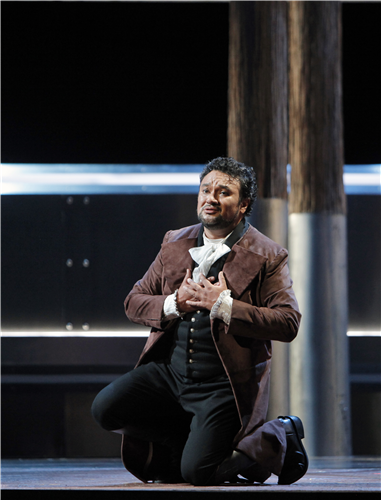 Werther, the central character in Jules Massenet's four act opera of the same title based on The Sorrows of Young Werther by Goethe is an emotional yo-yo. He experiences soaring highs and wallowing lows. If he were alive today, medics would brand him as being bipolar.
Werther, the central character in Jules Massenet's four act opera of the same title based on The Sorrows of Young Werther by Goethe is an emotional yo-yo. He experiences soaring highs and wallowing lows. If he were alive today, medics would brand him as being bipolar.Francisco Negrin's new production, which opened last night at the San Francisco Opera, is similar in character. The singing and acting is all-round superlative. I was extremely taken with the drama and dexterity of mezzo-soprano Alice Coote's performance in particular in the role of Charlotte, Werther's paramour. The tenor Raon Vargas was also superb at the titular moper. He combined lightness and gravity in equal amounts. He seemed extremely human.
But the mise en scene left much to be desired. The set, in particular, looked like it had been designed by IKEA, with its brushed steel walls and veneery-looking pale wood. When an oversized, overstocked bed was trundled on stage behind Coote, I almost lost it. And heavy-handed yet obscure symbolism abounded in the fussy use of angry red lighting and video. The design was screaming at us to read meaning into its various fussy details. But what exactly we were supposed to read at any moment, I wasn't completely sure.
Still, the singing and acting carried Goethe's yearning tale for me. I left feeling moved.
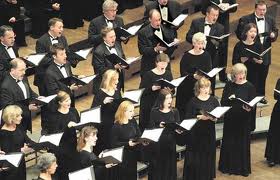 An interesting question came up over tea this morning with Helene Whitson, the creator of the useful and exhaustive Bay Area Choral Archive and one of the most enthusiastic and knowledgeable choral bods I've ever met. The subject under discussion was to do with professionalism in choral singing, but you could just as easily apply the same thoughts to professionalism in any field really.
An interesting question came up over tea this morning with Helene Whitson, the creator of the useful and exhaustive Bay Area Choral Archive and one of the most enthusiastic and knowledgeable choral bods I've ever met. The subject under discussion was to do with professionalism in choral singing, but you could just as easily apply the same thoughts to professionalism in any field really.What makes a choir "professional"? For Chorus America, and many other organizations and individuals, the distinction between amateur and professional choirs is largely related to finance. If you get paid for what you do, you're pro. If not, that makes you am.
Helene fervently disagrees with this definition and is in the process of trying to come up with a better way of categorizing choirs. "For me, professionalism is defined not by the amount of money that a chorister makes, but by his or her abilities as a singer," she says.
Helene's ideas come from years of watching choirs in action. She thinks that there are many paid choral singers who don't deserve to be paid and many others who don't get a dime for what they do, but are worthy of being compensated for it. It is this discrepancy which makes her want to change the way in which her own organization categorizes vocal ensembles.
I agree with Helene. I sing in a volunteer chorus. Many of its members are as good as anyone that gets paid to sing in, say, the San Francisco Symphony Chorus. But at the same time, I wonder if it's time to do away with the professional/amateur categories entirely. They're just not all that useful anymore. And even if Helene changes her definition in the Choral Archive database, it doesn't mean that the people who use her resource will adhere to her meaning.
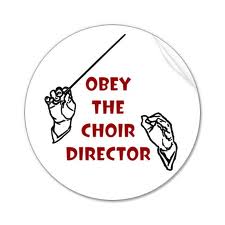 A question I've been asking myself lately is this: Why is it that so many choral conductors treat their singers like children? I'm talking adult ensembles here, not ones composed of minors.
A question I've been asking myself lately is this: Why is it that so many choral conductors treat their singers like children? I'm talking adult ensembles here, not ones composed of minors.I don't want to over-generalize as I know that the field has conductors that do not behave in this way. But judging by what people who've sung with a number of groups over the years have told me, the trait among music directors of patronizing their singers runs strong. It must be part of the job description.
I wonder whether the reason for this (or part of the reason at least) stems from the fact that choral singing is in many cases a pedagogical activity. It's the one music-making format with universal application possibilities. Many choral directors experienced singing in choirs as kids and many of them have directed ensembles of children, youths, students or maybe adults with no musical training whatsoever. The pedagogical aspect of the job mistakenly makes them think that they can talk down to the vocalists.
But the habit is exceedingly counter-productive, not to mention denigrating and annoying: As far as I can tell, music directors get better performances from singers when they don't harangue them as one might a naughty schoolchild. Plus, good singers are more likely to stick around than seek other opportunities if they feel like they are being treated like normal human beings.
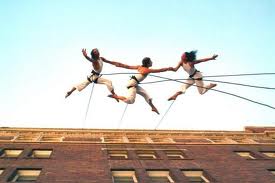 The weekend went by in a blur. Some highlights:
The weekend went by in a blur. Some highlights:1. Watching Project Bandaloop's amazing aerial dancers swoop and glide off the side of a 100 foot tall building in Oakland in preparation for the company's upcoming world premiere. The piece, which involves six dancers and is choreographed by artistic director Amelia Rudolph, explores the relationship between the different sides of the self and an individual's relationship to others. It's appropriately called IdEgo.
2. Hitting opening night of the new Mark Dion exhibition at the Oakland Museum. It's called Marvelous Museum and it involves the interjection of strange and unusual curios from the depths of the museum's storage facility into different parts of the permanent exhibition spaces.
3. Chris Kuckenbaker's weird and wonderful solo show at the San Francisco Fringe Festival all about William Burroughs. Well, to be more accurate, the piece is about the performer's imaginary relationship with a Burroughs'-like character in his head. Part self-confessional, part homage to the great, madcap author, the piece avoids being too self-indulgent and is full of humor and dextrous switches between characters.
4. Singing all day at a retreat with the International Orange Chorale in Larkspur. The ensemble with which I sing is performing Milton Babbitt's Music for the Mass among other new and newish pieces.
5. Hitting Pandora karaoke bar in the Tenderloin. Having sung all day, a group of us continued carousing till the wee hours of the morning. We had a private room, which was probably just as well, as we sang songs from The Sound of Music not to mention the Rod Stewart number, "If you want my body and your think I'm sexy..."
6. Enjoying a Sunday morning "gospel brunch" at 1300 Fillmore. The wonderful soul group Future Perfect performed while we ate. Gospel brunches are tacky things really and the prices are elevated. But we have fun anyway. The bottomless pomegranate mimosas (or "pomosas" as the waiter called the sweet fizzy pink beverages) certainly helped.
 This morning I awoke to the headline news of an explosion caused by a ruptured gas line in San Bruno (just a few miles from where I live in San Francisco.) The explosion killed at least six people, injured many more and destroyed lots of homes.
This morning I awoke to the headline news of an explosion caused by a ruptured gas line in San Bruno (just a few miles from where I live in San Francisco.) The explosion killed at least six people, injured many more and destroyed lots of homes.In the grand scheme of things, this disaster is small when compared to the floods, tsunamis, famines and nuclear power plant radiation leaks that commonly make the news all over the world. But irrespective of the size of the event, the repercussions never fail to have a devastating effect on a community.
In the face of this, what's a culture journalist to do? My colleagues on the news desks of the local and national media were probably up all night reporting the story and continue to make sure that people are kept up to date. The local pub that I contribute to, The Bay Citizen, has been at the forefront of the charge. I am impressed by the organization's coverage of the blast so far.
But what's my role as a journalist in all of this? No one cares what an arts reporter/critic has to say about a gas pipe rupture.
I suppose ultimately, at this point in time, my role is not a professional one. It's simply to be a good citizen by helping people in need while keeping a professional eye on how the story unfolds down in San Bruno.
When the proverbial smoke clears, that's when I can actually start doing my job -- making sense of the event and how it impacts people's lives from a cultural perspective. But that's down the line.
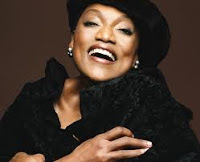 A note on Jessye Norman's performance at the season opener for The San Francisco Symphony on Tuesday night: It left much to be desired.
A note on Jessye Norman's performance at the season opener for The San Francisco Symphony on Tuesday night: It left much to be desired.The San Francisco Symphony Chorus did a beautiful job of sustaining Aaron Copland's long ardent lines in the haunting a cappella choral work In The Beginning. But the soloist's effort was bumpy to say the least.There was no flow between Norman's upper and lower registers and she didn't sing the Biblical text as if she knew what it meant.
The jazz set of songs by Duke Ellington arranged for voice and orchestra by Patrick Russ was even more disappointing. Norman's voice sounded thin at the top and bellowing at the bottom. She hammed up the sentiment in all the songs, which included such standards as "Come Sunday," "Sophisticated Lady" and "It Don't Mean A Thing (If It Ain't Got That Swing.)" At a couple of points, Norman's voice cracked.
Maybe the singer is tired. Clearly she needs a break.
 The current sorry state of the arts journalism profession was made very visible last night at the San Francisco Symphony's home base, Davies Symphony Hall.
The current sorry state of the arts journalism profession was made very visible last night at the San Francisco Symphony's home base, Davies Symphony Hall.Before the season opener kicked off with a program that included Michael Tilson Thomas conducting Berlioz's Roman Carnival Overture, Copland's In The Beginning for a cappella chorus and solo mezzo-soprano (Jessye Norman), a bunch of Duke Ellington standards (also sung by Norman) and Ravel's Daphnis et Chloe Suite No. 2, the organization's media relations department laid on a lovely party for the media.
The Davies Symphony Hall press room was remarkably packed and the atmosphere extremely convivial. It was nice to see so many familiar faces there.
But it wasn't until I took my seat for the concert that I realized that there had actually been precious few members of the press in the press room. It was largely populated by public relations people, funders and other assorted arts professionals and hangers-on. Out of a crowd of about 100 people, I counted maybe 10 journalists. Not an encouraging state of affairs.
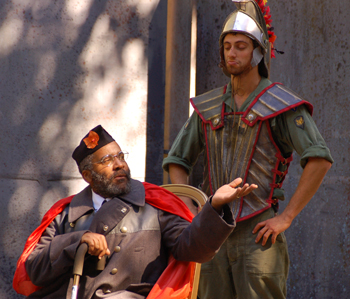 Shotgun Players is a Berkeley-based theatre company that never stops innovating. A few years ago it was one of the first - if not the very first - company in the United States to switch to solar power 100%. And it's never scared to be bold in terms of its programming while usually maintaining high artistic standards.
Shotgun Players is a Berkeley-based theatre company that never stops innovating. A few years ago it was one of the first - if not the very first - company in the United States to switch to solar power 100%. And it's never scared to be bold in terms of its programming while usually maintaining high artistic standards.The company manages to pursue these standards both for its indoor productions throughout the year at The Ashby Stage and for its outdoor productions each summer at John Hinkel Park in North Berkeley.
The current run of In The Wound, a new drama by Jon Tracy at John Hinkel Park is no exception. Instead of playing to most people's summery expectations of lighthearted Shakespeare and other romantic and/or fun-loving comedic fare, Shotgun Players is staging a violent adaptation of The Iliad. The production also sets itself apart from many others on the non-profit stage by having an enormous cast of more than 30 actors (the company's biggest cast size to date.) Tracy's production features committed performances and a strong sense of ensemble, especially during the forcefully choreographed fight scenes which make use of Taiko drumming and Asian war dances involving soldiers butting sticks and drums instead of swords and guns.
Yet for all that, I ended up feeling disappointed by In The Wound. I suppose the main issue I have with the production, which runs at weekends through October 3, is the writing. Here is yet another play which seems to say "war is bad" and little else. The language flits predictably (for a modern play about warfare with classical pretensions) between vaguely poetic cadences and slang. The characters only seem to have one dimension to them and the boomeranging structure of the drama is at times confusing. I couldn't really understand what was gained by flitting backwards and forwards through time in this telling of the story.
Still, I commend Shotgun Players for continuing to push boundaries in terms of its offerings and can only hope that the second Greek epic-inspired play that artistic director Patrick Dooley has commissioned from Tracy for the winter season, based on The Odyssey, will prove more inspiring in terms of the writing.
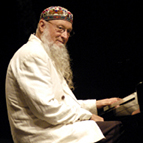 I imagine that there are few other places in the world you can go where, within the space of an hour or two, you can:
I imagine that there are few other places in the world you can go where, within the space of an hour or two, you can:1. Hear Terry Riley (pictured) play freewheeling proto-jazz compositions on the piano while wandering the galleries of the Berkeley Art Museum perusing 16th century Japanese art from the Clark Center Collection, an exhibition on "Hauntology" in art (a movement which tries to capture paranormal and other ghostly pricklings in our lives) and an installation and movie screening by the filmmaker and kinetic sculptor Brent Green.
2. Stumble across a bunch of students dressed in everything from Egyptian mummy's bindings to a burlesque dancer in the middle of an evening-length role play adventure based on the Cluedo board game.
3. Watch a legion of stunt cyclists tearing up a plaza with incredible balletic feats including moving very fast backwards like skaters moving on ice, doing pirouettes and hopping down concrete steps, all on two wheels.
 The relationship between public relations professionals and (arts) journalists often feels uneven to me. PR people seem to know much more about -- and are acutely sensitive towards the needs of -- the journalism profession than journalists know are are about PR people, as many PR people have been reporters or editors in the past (journalists rarely come to the profession from a career in marketing). And I think there are a lot of journalists who look down their noses at the PR industry. If a journalist leaves the profession to pursue PR, his or her colleagues will often accuse them of "selling out."
The relationship between public relations professionals and (arts) journalists often feels uneven to me. PR people seem to know much more about -- and are acutely sensitive towards the needs of -- the journalism profession than journalists know are are about PR people, as many PR people have been reporters or editors in the past (journalists rarely come to the profession from a career in marketing). And I think there are a lot of journalists who look down their noses at the PR industry. If a journalist leaves the profession to pursue PR, his or her colleagues will often accuse them of "selling out."This is ridiculous, as like it or not, journalists rely upon working with good PR people more than they care to admit.
A few weeks ago, the head of one of the PR firms in the Bay Area, David Landis (pictured), asked me to participate in a new feature on his company's website called "Meet the Media." I had to answer a few questions about my job and send in a photo. I did what was asked and the result can be seen here.
The exercise made me realize how little I know about David Landis, and most of the other PR people I work with regularly for that matter.
So I decided to ask David if he would return the favor and answer a set of very similar questions to the ones he had asked me so that I could find out about what he does and post the findings on my blog. David obliged.
So here's the first installment of "Meet the Marketer," my response to Landis Communications' "Meet the Media":
David Landis, President & CEO of Landis Communications
1. What's your top project for today?
Today, our LCI team is pitching a new health-related business in the far reaches of the East Bay. Pitching new business isn't the worry, I love learning about new businesses and helping them think strategically about how to communicate their value - the real issue is how am I going to get there and avoid the traffic/construction and arrive on time? I'm also meeting a former staffer for lunch who now lives out there.
2. Tell us about your dream client.
A dream client is one who truly partners with LCI so that we can be successful. What does that mean? That they hold up their end of the bargain - make sure to respond to us with information, honor our weekly meetings, pay on time - and most importantly: get back to us asap when we have an interview opportunity. We also want partners who understand that the true value LCI brings to the table is strategic counsel - clients may elect to not implement that counsel, but it's important to be heard. Often times, it's the PR professional who can bring fresh ideas, new directions and a unique way of approaching the business.
3. Describe the wackiest marketing campaign you've worked on.
Here are a few from which to pick:
When we launched Old Navy, we did a program to help promote their $5 Flag T-shirts. We partnered with summer reading programs at libraries throughout the U.S. and had actresses impersonate Betsy Ross (the creator of the flag) to teach kids about the flag. We launched on Flag Day and then culminated the campaign with small-town parades in cities across the country for July 4th. The greatest part was that the T-shirts sold out in record time and those T-shirts have become an annual anticipated event.
With a holiday shopping site called Santa.com, we produced the first-ever Santa.com holiday parade with a then unknown singer named Christina Aguilera as the emcee. She was very young and wasn't paying attention - and when the music started, she forgot to start singing!
For Match.com, we created a new expert program with the in-house PR person - letting the press know that our expert could address all questions related to the dating world, either online or off-line. Instead of just trotting her out to the press, we re-named her the "VP of Romance," and suddenly the press was calling us, asking if they could get expert commentary from her. As a result, we placed her on the Today Show, in the New York Times and all throughout the country.
This isn't "wacky", but it was amazing. With the California Academy of Sciences, one of their researchers found research that would indicate that humans had actually been using tools 1,000,000 years prior to what had been thought before. When that news broke, it made Associated Press, Wall Street Journal, NPR, New York Times and more - and prompted opposing scientists to immediately question the science - a PR person's bonanza because controversy always means more exposure!
And years ago, to promote the Symphony Pops, we created the first "champagne cork-popping" contest with area celebrities - to see who could pop a champagne cork the furthest. SF Chief of Protocol Charlotte Shultz of course won - with her indomitable style and class.
We also did a "Mozart look-alike" contest at the Symphony - partnering with Macy's - but only got 2 entries: a guy on a boat with a beer can in his hand and a single Mom from Antioch. I'd say that one fell a little short of our expectations!
4. What is your journalism pet peeve?
We'll do our part to make sure we're pitching you appropriately (i.e., we'll do the research, make sure we understand your beat etc.) Just get back to us and let us know whether or not you're interested in the story. We really don't want to be a pest, but if we don't hear back from you, we'll assume there's still a chance for that story.
5. Top trend in the industry you're currently interested in.
I think social media is already changing and will continue to revolutionize the way we conduct PR and how the business operates. No longer will a majority of our work as PR professionals be dedicated toward interesting media to write about our clients (although unlike some, I predict this will still remain an important component of our business). But what social media affords PR and our clients is the opportunity to communicate directly with our customers without the filter of the media. That is groundbreaking.
6. Tell us a little about yourself.
What most people don't realize is that I started my career as a pianist. I studied piano performance at Northwestern University in Chicago and then moved into arts administration, before going into television. I started the agency business more than 20 years ago in my bedroom and we now have about a dozen employees, are part of an international PR network (Public Relations Global Network - www.prgn.com) but also remain committed to helping businesses grow - and helping the community through our nonprofit work. I think having a creative outlet - like my music - has allowed me to think differently about business in general and bring some fresh thinking and ideas to the table. For those going into any business, I think a background in the arts is essential. I also love to travel, love skiing and hiking, can't get enough of San Francisco's amazing culinary scene and adore theatre. Meeting Stephen Sondheim a couple of years ago was a true high point in my life. I'm married to my now husband of 21 years, Sean Dowdall, who is Chief Marketing Officer for Rabobank and we live in Pacific Heights (and in Tahoe) with our two adorable American Eskimo dogs, Shasta & Whitney. My other career if I weren't in PR would be playing cocktail music in an upscale lounge.
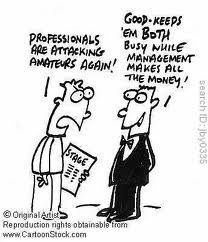 As someone who resides in a country where the terms "professional" and "amateur" have become practically meaningless in the world of the theatre, I was fascinated to read in yesterday's edition of The Stage that Britain's mighty Royal Shakespeare Company will feature "an increased focus on amateur theatre" when it re-opens on November 24 in Stratford-Upon-Avon.
As someone who resides in a country where the terms "professional" and "amateur" have become practically meaningless in the world of the theatre, I was fascinated to read in yesterday's edition of The Stage that Britain's mighty Royal Shakespeare Company will feature "an increased focus on amateur theatre" when it re-opens on November 24 in Stratford-Upon-Avon.Alistair Smith's article quotes RSC director Michael Boyd as saying:
"As part of a programme of work between now and 2012 with the World Shakespeare Festival, we are very interested in trying to renegotiate the relationship between amateur theatre and professional theatre in this country. We're sticking the amateurs centre stage with our opening - with an open house night of local amateur performers, with another night where there's amateur choirs from across the UK, as well as a major thing from school kids...There's been a sort of crucifix and garlic mutual relationship between the amateur sector and the professional sector for too long. It's been fine for professionals to work in 'community theatre', that's been kosher, but to actually acknowledge that quite a substantial proportion of people working in professional theatre started out in local amateur groups, that is a well kept secret. People pretend they know nothing about it, but it is the case. I think there is something about the relationship that an amateur theatre has with its audience that we in the professional theatre can learn from, and there are obviously skills that we can share."
The RSC's decision is very much in keeping with a general trend where museums, symphony orchestras, dance companies and myriad other types of arts organizations are looking for ways to make their work more inclusive and interactive.
I wonder if theatre is the final frontier in the UK for bringing so-called amateurs and professionals together? It strikes me that there has always been such a stigma against "am dram" in Britain. This view doesn't exist to the same degree in the US. I don't think that it will go away just because the RSC has decided to acknowledge the place of community theatre, especially since much of the amateur-inclusive programming appears, at least as it's described in the article, to be more of a gesture to draw attention to the launch of the new RSC than a concerted effort to engage amateur theatre people in the long term. It's a laudable gesture, mind you. But perhaps the RSC's move signals the start of a greater acceptance that the worlds of amateur and professional performance have a lot more in common than people like to think?
Over here, the two categories have been bleeding into one another for decades, partly because of the paucity of funding for theatre at any level. The Brits could learn a thing or two from watching how the worlds of amateur and professional theatre, such as they are, interact in the US.
 A friend and I had a discussion this morning about how possible it is for an audience member to detach his or her experience of seeing a staging of a play from the play text itself. We disagreed.
A friend and I had a discussion this morning about how possible it is for an audience member to detach his or her experience of seeing a staging of a play from the play text itself. We disagreed.My friend thinks that if a play is great, you can still enjoy a production of it, even if the production is very bad. He looks at the staging as an inconvenience and a distraction, but no matter how ham-fisted the mise-en-scene is, it ultimately doesn't stop him from enjoying the play -- as in the words on the page -- itself. "It's hard to fuck up Macbeth," is what he said.
I feel very differently about this. A bad production can completely wreck a play for me, no matter how great the source text might be.
I envy my friend's ability to divorce the text from the staging. I have never been able to do it. For me, plays are no good simply sitting on the page. I mean, they're OK. I like reading plays. But plays are meant to be put on stage. That's where they're supposed to come to life. A lifeless production cannot help but kill the dramatist's words.
 ...Why isn't it ever any good?
...Why isn't it ever any good?
